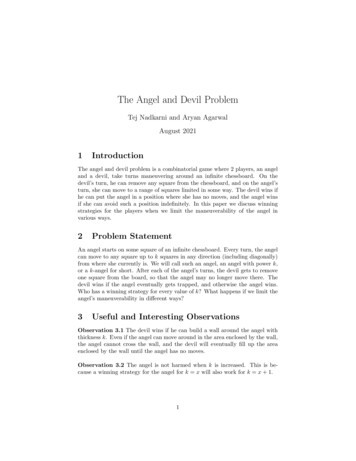
Transcription
The Angel and Devil ProblemTej Nadkarni and Aryan AgarwalAugust 20211IntroductionThe angel and devil problem is a combinatorial game where 2 players, an angeland a devil, take turns maneuvering around an infinite chessboard. On thedevil’s turn, he can remove any square from the chessboard, and on the angel’sturn, she can move to a range of squares limited in some way. The devil wins ifhe can put the angel in a position where she has no moves, and the angel winsif she can avoid such a position indefinitely. In this paper we discuss winningstrategies for the players when we limit the maneuverability of the angel invarious ways.2Problem StatementAn angel starts on some square of an infinite chessboard. Every turn, the angelcan move to any square up to k squares in any direction (including diagonally)from where she currently is. We will call such an angel, an angel with power k,or a k-angel for short. After each of the angel’s turns, the devil gets to removeone square from the board, so that the angel may no longer move there. Thedevil wins if the angel eventually gets trapped, and otherwise the angel wins.Who has a winning strategy for every value of k? What happens if we limit theangel’s maneuverability in different ways?3Useful and Interesting ObservationsObservation 3.1 The devil wins if he can build a wall around the angel withthickness k. Even if the angel can move around in the area enclosed by the wall,the angel cannot cross the wall, and the devil will eventually fill up the areaenclosed by the wall until the angel has no moves.Observation 3.2 The angel is not harmed when k is increased. This is because a winning strategy for the angel for k x will also work for k x 1.1
Observation 3.3 A position is no better for the angel than the same position with an extra square removed. This is because the angel has no more andno better options than in the original position.Observation 3.4 A k-angel can move to (2k 1)2 1 squares on her turn(assuming none are blocked).Definition 3.5: Let the Altered Angel and Devil Problem have the extra condition that the angel cannot go to a square she could have gone to on a previousturn. I.e. when the angel leaves a square, that square, and all of the (2k 1)2squares she could have moved to on that turn, are removed from the board(except for the square the angel lands on).Theorem 3.6 For any value of k, the player with the winning strategy forthe Angel and Devil Problem will also have a winning strategy for the AlteredAngel and Devil Problem.Proof. It is clearly impossible for the angel to win the altered problem if thedevil wins the normal problem, since removing squares cannot help the angel.We will now prove that it is impossible for the devil to win the altered problemif the angel wins the normal problem. Let us assume on the contrary that thedevil won the altered problem while the angel won the normal problem. Thiswould imply that the angel’s winning strategy for the normal problem wouldinvolve returning to at least one of the (2k 1)2 squares. When the angel movesto a square she could have gone to on a previous turn, the devil will ignoreeverything that has happened since the angel was at the center of the (2k 1)2square, and pretend that the angel moved directly from the center of the square,to where the angel currently is. The devil would have blocked out extra squaresby the time the angel reaches its current square, thus the devil will be strictlybetter off in this case than when the angel directly moves to the square sheis currently on. Thus returning to such a square is sub-optimal, which is acontradiction. QEDFigure 1: The area that a 1000-angel blocks every turn is much larger than thearea the devil blocks. [1]2
4Case Where k 1Setup 4.1 First we will solve the problem for k 1, which is the easiest casefor this problem. The devil has the winning strategy. Let us note that theangel moves like a chess king. We, as the devil’s advocate, must construct awall with a thickness of 1 around the angel. The angel has the first move. Afterher move let us call the square that she is on, the origin i.e. (0, 0). WLOG,let this square be white (the rest of the plane will be tiled like a normal chessboard). Let the square x units right, and y units up from the origin be (x, y).We will construct a wall on the perimeter of the square connected by the points( 27, 27), (27, 27), ( 27, 27), and (27, 27). (We choose a 55 55 grid tomake the proof easier, a 32 33 grid works as well.)We will start by removing the following 20 squares: (27, 27), (27, 27),( 27, 27), (27, 27), ( 26, 27), (26, 27), ( 26, 27), (26, 27), ( 27, 26), (27, 26),( 27, 26), (27, 26), ( 25, 27), (27, 25), ( 27, 25), 27, 25, (25, 27), (25, 27),( 25, 27), (27, 25). (The 5 squares, on the perimeter of the 55 551 square,closest to each corner are removed.) After we remove (27, 25), and the angelmoves, the angel must be within the square enclosed by the points ( 20, 20),(20, 20), ( 20, 20), and (20, 20). We will now use Algorithm 4.2 to determine which square to remove.Algorithm 4.2 If the angel is in the 49 49 square, we will remove2 theclosest3 white square to the angel that is on the perimeter. If there are multiplesuch squares, we will remove the square that is furthest from another removedsquare. If there are still multiple such squares, we will remove a random one ofthese squares. We will continue this process until we run out of white squares inwhich case we will switch to black squares, or until the angel leaves the 49 49square. If the angel ever wanders back into the 49 49 square, we will revertback to the algorithm described in this paragraph.If the angel is not in the 49 49 square, we will remove the square (notnecessarily white) closest to the angel. If there are multiple such squares, wewill remove the square that is furthest from another removed square. If thereare still multiple such squares, we will remove a random one of these squares.We will continue this until the wall is completed (and we win) or until the angelwanders back into the 49 49 square in which case we will revert back to thealgorithm described in the previous paragraph. We will continue until we finishbuilding the wall.Theorem 4.3: Algorithm 4.2 is effective in trapping the angel.1 If an n n square is mentioned without a specified center, assume the center to be theorigin.2 Until a wall is fully constructed around the angel, we will not remove any squares thatare not on the perimeter of the 55 55 square. This will always be a constraint on whichsquares we will remove.3 The distance between two squares is equal to x x y y where (x , y ) and12121 1(x2 , y2 ) are the coordinates of the squares.3
Proof. The angel will escape the 55 55 square iff she can ”fork”4 two ormore squares on the perimeter of the square. (This is why we remove the cornersquares. If the angel is near the corner, five squares can be attacked at once.)Recall that after we remove (27, 25), and the angel moves, the angel must bewithin the 41 41 square. This means that we will remove at least five whitesquares before the angel leaves the 49 49 square. This means that after theangel leaves the 49 49 square, all white squares on the perimeter, two unitsto each side of the angel, will be removed. On her next move, the only way theangel will be able to fork two squares on the perimeter is by forking two blacksquares. By removing the closest square (which will be black) we will preventthe angel from forking two such squares. No matter where the angel moveswe will always be one step ahead (literally and figuratively - see the figure tounderstand one case of Algorithm 4.2). QEDFigure 2: A visual depiction of Algorithm 4.2. Deep Red marks (0, 0),light blue indicates moves of the Angel (along with move number),light red marks the first 20 moves of the Devil, and peach marksthe subsequent moves of the Devil from 21 to 216. The Blue borderindicates 40 40 square, and the Green border indicates the 49 49square. The Angel moves first. After 216 moves, the wall is complete.4 Inchess a fork is when a piece attacks two or more pieces at the same time.4
5FoolsThe following games are all necessary proofs that show the complexity of theAngel’s winning strategy. On the surface the Angel might seem much strongerthan the devil, but common strategies can fall prey to macroscopic traps, as wewill now see.Definition 5.1 There are various types of fools. A generic fool is an angelwith her abilities limited in some way.Definition 5.2 A k-fool is a k-angel that increases her y-coordinate every turn.Theorem 5.3 The devil will beat a k-fool.Figure 3: Capturing the k-fool [1]Proof. Whenever the k-fool is at some point P : P (xP , yP ), her futurepositions will be limited to the cone defined by all squares, (x, y), satisfying(y yP ) d x xP e.kThe devil will start by choosing an horizontal line that is a very large power of2 above P . We will define the points where the cone intersects this line to be Aand B. Let the height of the triangle formed be H. The devil will then remove1 out of every 4k squares on the line AB so that the devil finishes by the timethe fool is H2 away from AB. The angel will now be at point Q, and be limitedto a cone of half the size. The new cone will intersect line AB at points C andD. The devil will again remove 1 out of every 4k squares on line CD, so thatthe devil finishes by the time the fool is H4 away from line CD. We will repeatthis process 4k 2 times until a wall of thickness k is constructed above the fool.Definition 5.4 A lax k-fool is a k-angel that never decreases her y-coordinate.5
Figure 4: Catching the Lax k - fool [1]Theorem 5.5 The devil will beat a lax k-fool.Proof. The devil will use his odd moves to convert the lax k-fool into a normalfool of a greater power. The devil chooses two points, L and R, 4k 2 units tothe left and right of P , the starting position of the lax k-fool. As long as thelax k-fool stays on the first row, the devil will use his odd moves to alternatelyremove squares starting at R and L, moving left from R, and right from L. Thuswe remove a square to the right and left of the lax k-fool every 4 turns. Thus in4k turns we will have constructed a wall of thickness k to the left and right ofthe lax k-fool. If the lax k-fool continues staying on line LR then the lax k-foolwill be forced to move upwards after 16k 2 turns. Thus, after 16k 2 moves thelax k-fool must move upwards. Since the lax k-fool must move upwards onceevery 16k 2 moves, it is in essence a 16k 3 -fool. The devil will use his even movesto trap the 16k 3 -fool. QEDDefinition 5.6: A relaxed k-fool (of laxity z) is an k-angel that does not decrease its y-coordinate by more than z, where z is some fixed arbitrary positiveinteger. Thus, if the relaxed k-fool’s starting position is (x, y), and some timelater its position is (X, Y ), then Y y z.Theorem 5.7: The devil can catch a relaxed k-fool.Proof: The devil adapts his strategy of dealing with the lax k-fool to beatthe relaxed k-fool. Let P be the starting position of the relaxed k-fool. Thus,we take a suitable distance D as before from P to the left (L) and right (R) ofthe relaxed k-fool. We choose D at such a distance that the devil has enoughmoves to create 2 rectangles of width k and length z in the negative y-direction.Thus, by the time these canyons are created, if the relaxed k-fool kept moving6
Figure 5: Catching the Relaxed Fool [1]downwards, she is bound by the limit z we imposed in definition 5.6. Now,she has no choice but to increase her y-coordinate and cannot stay in the planebelow P as she is bound by the 2 canyons the devil created, and will eventuallybe caught. After some moves, she will finally rise above P , and now the devilcan now use the strategy for the lax k-fool to trap the relaxed k-fool. QEDDefinition 5.8: Let the Out-and-Out k-fool be an k-angel who promises tostrictly increase her distance from the origin (her starting position) on all moves.Figure 6: Kaleidoscope for capturing an Out-and-Out Fool [1]Theorem 5.9: The devil can catch an Out-and-Out k-fool.Proof: Before embarking upon this proof, let us discuss the board that thisproblem is played on. Is it necessary that we play on a chess board of side ?No. We can also play the game on a Euclidean plane where the Angel can ”fly”to all points in a radius k while the Devil can eat any point from a unit disk inthe plane. For example, if a k-angel is confined to a particular conical section,7
and promises to strictly increase her distance r from the Vertex O, we see thatthe cone transforms into a triangle, the r coordinate becomes the y coordinate,and the Devil’s winning strategy for the k-fool applies.Figure 7: Transformation of Euclidean Plain regions to graph regions [1]This is quite a powerful observation, as it helps us further generalize thesolution to the Angel and Devil problem. Since the Out-and-Out k-Fool is capable of moving in all directions, we represent the situation as a graph with acircle with center (0, 0) and radius a distance k as discussed in previous proofs.Thus, the devil has a winning strategy by dividing this circular plane into 2nsectors. If we imagine the circumference of the circle to be mirrors placed in akaleidoscope, there 2n images, one in each sector. Thus, when the Out-and-Outk-Fool moves in any sector, we transform it into a triangle (as described above)and thus we can use the proof for the k-fool to win. There is some distortioncaused due to transforming the conic section into a triangle, however we roughlyfind that an Out-and-Out Fool is of the form of a 2nk-fool. QEDDefinition 5.10: Let a Relaxed Out-and-Out k-fool be a k-angel that promisesnot to reduce her distance from the Origin by more than z, where z is somefixed arbitrary positive integer.Theorem 5.11 The devil can beat a Relaxed Out-and-Out k-fool.Proof: We can reduce a Relaxed Out-and-Out k-fool to a relaxed k-fool thesame way we reduced the Out-and-Out k-fool to a plain k-fool above. Usingthe idea of transformation, we get the same inequality as before, albeit withslight distortions in strategy due to the transformation. Thus, if the Angel’sstarting position is (x, y) and its final position is (X, Y ), then Y y z. Thisis a powerful proof and we will use this idea in proving an extremely importantstrategy for the devil: the Blass-Conway Diverting Strategy.Thus, even complex strategies like the Relaxed Fools are easily beatable by thedevil. This goes to show that any winning strategy for the Angel at k 2 mustbe significantly more complex, and the Angel must follow a counter-intuitivestrategy to win.8
6Blass-Conway Diverting StrategyThe Blass-Conway Diverting Strategy is a theorem that provides a very powerfulstrategy for the devil. However, it is not a conclusive proof for the case k 2.It simply shows the strategies that are ’foolish’ in nature must be avoided bythe Angel if she is to win.Theorem 6.1: There exists a diversion strategy for the Devil such that foreach point P and each distance D in a plane, there will be a time t2 : t2 t1such that the k-angel is D units nearer to P than she was at time t1 , for all Pand D.Proof: We have different combinations of P and D of the form: (P0 , D0 ),(P1 , D1 ), (P2 , D2 ), (P3 , D3 ), and so on. We can interpret such a game as aRelaxed Out-and-Out k-fool that promises not to go farther than Dn from Pnfor all n N. The devil can thus use his odd moves to trap the Angel whenn 0 as explained in Theorem 5.11. By applying the same theorem again,the Devil can use his moves, that are 2 times an odd number, on n 1 to win.Thus, the devil can meet the nth requirement by playing the strategy for theRelaxed Out-and-Out k-fool on his (2n · O)th moves, where O is an odd number.This theorem thus generalizes all the approaches for the devil in the fool scenarios. Thus, The Blass Conway Diversion Strategy is the roadmap for the Devilto win the Angel Problem, if indeed he is winning.7Closing Remarks:Through this paper, we have introduced the Angel Problem and described certain observations needed to find a general solution. We then utilised theseobservations to prove that the devil wins the k 1 case, if he uses Algorithm4.2 as his strategy. In a pursuit to solve the general case of k 2 we coveredthe different fools to show that various intuitive strategies for the Angel failquite easily. We then used the proof of a Relaxed Out-and-Out fool to derivethe Blass Conway Diverting Strategy - a general winning strategy for the devil.However, we saw that this theorem is not a conclusive proof for the general casek 2 and only serves as a proof to show how the Devil can potentially win agame.At this point the reader might be thinking that the devil is the clear victorof the game, however, the true power of the angel is vastly underestimatedwhen we compute the outcome of the fools. Despite the multitude of theoremsand examples in favour of the devil winning the Angel Problem, John Conway9
was still convinced that there is a winning strategy for the Angel when k 2,and even offered a cash prize for whoever managed to solve the problem. Andras Mathe and Oddvar Kloster both separately offered proofs, showing thatthe angel wins k 2.[2] Kloster described the winning strategy for the 2-angelto be to travel north as quickly as possible and detour around removed squares,if the added distance will not be more than twice that of the number of eatensquares avoided.References[1] John H Conway. The angel problem. Games of no chance, 29:3–12, 1996.[2] Oddvar Kloster. A solution to the angel problem. Theoretical ComputerScience, 389(1-2):152–161, 2007.[3] Martin Kutz. The Angel Problem, Positional Games, and Digraph Roots.PhD thesis, PhD thesis, Freie Universität Berlin, 2004. http://www. diss.fu-berlin. de . . . , 2004.[4] Johan Wästlund. A weaker winning angel, 2008.10
and a devil, take turns maneuvering around an in nite chessboard. On the devil’s turn, he can remove any square from the chessboard, and on the angel’s turn, she can move to a range of squares limited in some way. The devil wins if he can put the angel










